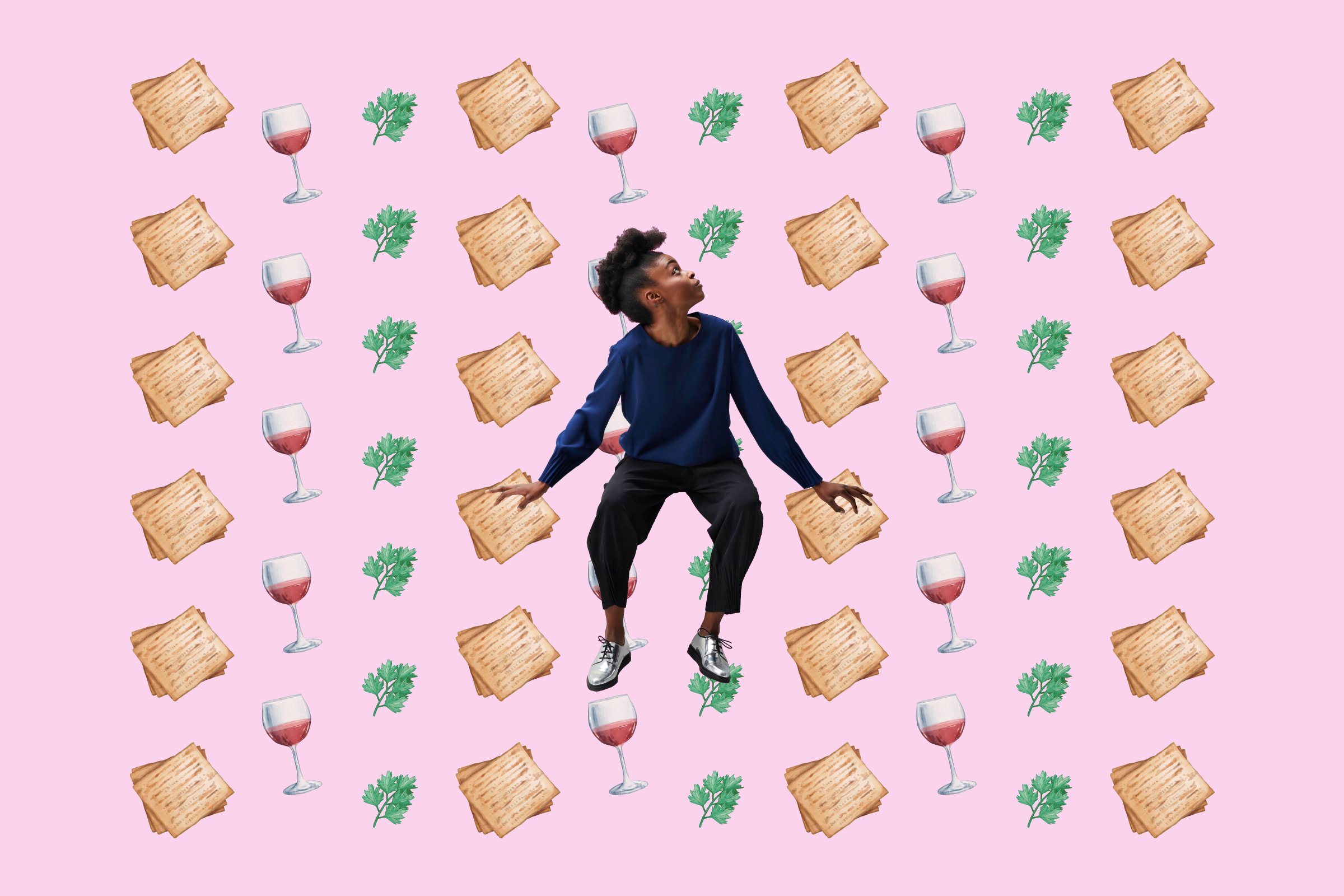If it’s slowly dawning on you that, chances are, you’ll be on your own this Passover seder, the first step is coming to terms with it. We are living in a time of unprecedented change, and it is natural to be experiencing grief, sadness, anxiety, and plain old FOMO. For me personally, knowing that I have family members gathered in Australia having an intimate, no-guests seder table brings up some envy and a bit of resentment that I’m here in Jerusalem alone with my roommate. The first step is being okay with the feelings that come up and acknowledging that they’re there.
If you are planning on joining a virtual seder, that’s an option, but for some of us, whether it’s due to your personal Jewish practice or screen fatigue, this could be an opportunity for us to get deep with our own personal journey.
What if you can use this opportunity to focus on reading the Passover story anew and thinking about how it applies to you in your life, without the kids shrieking or brisket burning or the uncle’s awkward commentary running in the background?
I’m here to tell you that you can. Here’s how.
Remember that you have the power
The seder is the ultimate experiential education. It is an experience for each of us to go through what it is to leave Egypt. It requires no skills, but is full of ceremony. There is no prerequisite, no educational requirement, no rabbi or cantor needed to make it real. It is a moment for each of us to take our experience into our own hands, and bring our Judaism into our homes.
In the times when the Israelites had a Temple, in fact, the Passover sacrifice was the only ritual ceremony that could take place off the Temple grounds (as long as it was within sight), so many ate in the courtyards of their homes. So remember that this isn’t a second best option — your own seder, at home, is exactly where you are meant to be.
Gather the resources you need
From a ritual standpoint, the most important piece of the evening is a haggadah, the book that takes you through the steps of the seder. If your Amazon deliveries are four weeks out due to the current crisis, you can always print or download a haggadah online. Sefaria has the full text of the haggadah online in Hebrew and English; the Open Siddur Project has a full list of various versions of haggadahs with commentary; haggadot.com helps you piece together your own haggadah from various sources; and my website The Gene-Sis will soon be publishing a full Haggadah commentary especially for those spending seder alone this year (sign up to get the download link when it’s ready).
Other ritual items that would be lovely to have, but can also be improvised at home, include:
- A beautiful kiddush cup, wine glass, or other kind of special cup to drink your four cups of wine
- A beautiful cup, wine glass, or other special cup(s) you want to designate for Elijah’s cup (and Miriam’s cup!)
- A seder plate, or other special place you can designate for your matzah and seder plate items. This could be a beautiful woven place mat; a really pretty plate; or a piece of fabric.
- Your seder plate items! Some of these will be easier to obtain than others. Traditionally, the seder plate includes some form of dark greens as a bitter herb, fresh horseradish if that’s your thing (also as a bitter herb), a hard boiled egg, an overly-grilled not-to-be-eaten shank bone (use a chicken bone), and the fun part, haroset (very simple to make your own!)
- A cover for your matzah — again, embroidered pretty fabrics work great!
- Three pieces of matzah and enough wine for four cups (plus more if you like to drink with your dinner…)
Focus on your space
Gourmet wines and family recipes are delicious and enhance the experience, but there’s no mitzvah in having crystal goblets and Grandma’s matzah balls to make your seder perfect. Think about the basic menu that will make you — just you! — happy, so you have a delicious meal waiting for you. Get the wine that you like most, even if it makes your sommelier cousin scoff. And decorate your space so it’s beautiful and comfortable. Traditionally, the Passover seder was conducted reclining on luxurious beds and cushions, leaning the entire night like the queens we are, celebrating freedom — so why not deck out your living room in a decadent spread of cushions? Yes, I am telling you to build a seder fort.
Dress up
If you’ve been spending your last few weeks going from night pajamas to couch pajamas, you’ve probably gained a newfound appreciation of “loungewear.” Our ancestors also saw the seder as a time to be super comfy, reclining like royals, so why not whip out that silk kimono you keep for special occasions? Or find a glorious plush robe that makes you feel amazing? You can even go with something that could pass as the traditional white ceremonial kittel robe.
Light candles
The candlelighting ceremony that opens up Jewish holidays and Shabbat is one of the best mood-enhancers on the planet. It’s a time to invite in the peaceful, calm energy you want in your home, and connect to your heart, yourself, and whatever you call Divine. I also use this time to think of my family, bless them from afar, and maybe sob a tear or two (acknowledging those feelings!) when I’m far away.
Light two candles, set them up beautifully on your table, and recite the blessing before the seder begins. Setting your intention for an evening of spiritual growth while using the template that our ancestors have been using for millennia is exactly how we like to start off a ritual.
Remember that this is yours as much as anyone else’s
The entire Passover haggadah is based around a quote from the Bible which tells us, “You will tell this story to your children on that day.” This ritual is something that was performed in hidden cellars in Russia and Spain; in ornate palaces in Hungary and Iran; in concentration camps in Eastern Europe; on cushions in ancient Babylonia; and this year, in our own little apartments all over the world during this time of global transformation. It’s time to find your own space inside these texts.
When asking the Four Questions, come up with your own questions to God or the world on this night, about what makes this time different than any others. When recounting the story of going from slavery to freedom, think about the impactful moments in your life and how you would like to emerge from this difficult time of chrysalis to become the caterpillar-turned-butterfly we are all becoming. When singing Dayenu, list your own gratitudes for the goodness you have in your life right now. Spill out wine for the plagues happening around the world as much as those of ancient Egypt. And when opening the door for Elijah, whisper your prayer for the world we are building even as the old world is burning down.
Say the words aloud — it’s not about anyone hearing you, but about you hearing yourself. Add your own commentary to the side, or print out the commentaries and stories that resonate with you best. Make this into your moment, your ceremony, your ritual. Your time to reflect, your time to contemplate, your time to celebrate.
Sing your heart out
In my humble opinion, the best part of seder night is the period of “Hallel,” songs of joyous praise at the end. For those of us with raucous families or leaders who like to draw out certain sections, we might never make it to this point, instead finding ourselves red-wine-sleepy before we get to the juicy songs.
But this is your night, this is your ceremony, so when it’s time, get the praises going and sing your heart out. Sing old Passover tunes from Hebrew School, contemporary Hallel tunes by Jewish music pioneers, or your own renditions of songs of freedom. After all, we know every good party ends with a dance party, and now you can dance like nobody’s watching because they most definitely are not.
Next year in Jerusalem?
This seder is your own, and an opportunity to see what it takes to make Judaism your own, too. Our tradition has been the fabric of life for so many thousands of years precisely because of its resilience, the ability to generate amazing things in times of strife, from expulsion to exile to plague. While our buried traumas rise to the surface, we also find inside our deepest resilience, that same ability to renew and begin again that our ancestors took with them from so many tragedies in the past.
Judaism was made for these times, and it is here for us to grasp, to grow, to develop within these structures our own way of connection, creation, and restoration. As we end our seder with the wish to spend next year in Jerusalem, take the time to meditate on your personal wishes for the year ahead. We are living in unprecedented times, and while that means this was beyond our imaginations a year ago, it also means that the possible world we are praying for could also be just around the corner. All we need to do is will it into being.
For a full set of ideas for personal reflections, meditations and ways to make a solo seder meaningful, sign up for Rishe’s Solo Seder Companion. I am also taking questions and suggestions at this time via email.
Header Image design by Grace Yagel/passover icon illustrations via freepix/woman via Klaus Vedfelt/Getty Images.



